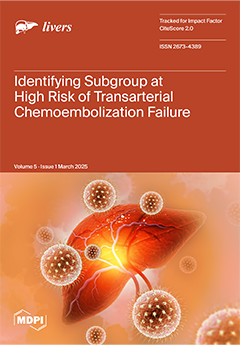Open AccessEditor’s ChoiceArticle
Identifying Subgroup at High Risk of Transarterial Chemoembolization Failure Among Patients with Hepatocellular Carcinoma Awaiting Liver Transplantation
by
Edoardo Poli, Marc-Antoine Allard, Astrid Laurent-Bellue, Maïté Lewin, Catherine Guettier, Daniel Azoulay, Audrey Coilly, Alexandre Dos Santos, Jamila Faivre, Eric Vibert, Alina Pascale, Clara Prud’homme, Antonio Sa Cunha, Faouzi Saliba, Jean Charles Duclos-Vallée, René Adam, Didier Samuel, Daniel Cherqui and Olivier Rosmorduc
Viewed by 1218
Abstract
Background/Objectives: Transarterial chemoembolization (TACE) is the most widely used bridging treatment for hepatocellular carcinoma (HCC) before liver transplantation (LT) but may be associated with dropout and post-LT HCC recurrence. We aimed to identify a subgroup of HCC LT candidates at high risk of
[...] Read more.
Background/Objectives: Transarterial chemoembolization (TACE) is the most widely used bridging treatment for hepatocellular carcinoma (HCC) before liver transplantation (LT) but may be associated with dropout and post-LT HCC recurrence. We aimed to identify a subgroup of HCC LT candidates at high risk of TACE-to-LT strategy failure (TLSF). Methods: All consecutive HCC LT candidates with French AFP-scores ≤ 2 who underwent at least one bridging TACE at Paul Brousse Hospital in 2013–2018 were included (n = 173). Dropout for HCC progression during waiting list and post-LT HCC recurrence was defined TLSF. Results: The one-year TLSF cumulative incidence was 15%. According to univariate analysis, pre-TACE AFP > 15 ng/mL was the only factor associated with decreased overall survival (OS) and TLSF-free survival (TLSF-FS) after the first TACE. The absence of complete radiological response (CRR) or pre-TACE AFP > 15 ng/mL were associated with reduced OS and TLSF-FS after a second TACE (n = 118). The cumulative incidence of TLSF reached 41% one year after the second TACE in patients with both AFP > 15 ng/mL and no CRR, while it was 7% for others (
p < 0.001). Conclusions: HCC patients receiving bridging TACE, with pre-TACE AFP > 15 ng/mL and no CRR after two TACEs, are at high risk of delisting for HCC progression or of post-LT recurrence. Alternative therapeutic strategies should be proposed early for this better-defined population.
Full article
►▼
Show Figures





